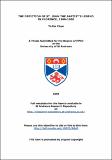The depiction of St. John the Baptist's legend in Florence, 1300-1500
Abstract
This thesis focuses on the portrayal of St. John the Baptist in Florence during the
fourteenth and fifteenth centuries. The first chapter is devoted to the examination of
the Baptist's legend as outlined in the Bible and apocryphal texts in order to draw a
picture of the saint's legend as the Florentines of the Renaissance would have
understood it. The interest in the image of the Baptist stemmed from his position as
patron saint of the city. As a result of this state of affairs, a discussion of the origins
of the city's adoption of the saint is essential to our understanding of his importance
in Florence. This analysis together with a description of the Festival of the Baptist
celebrated in the city, forms the background to a fuller understanding of the works of
art under discussion.
The examination of Florentine works of art dealing with the Baptist's life
concentrates on eight full pictorial cycles. These comprise four projects for the
Florentine Baptistery (the mosaic programme in the Baptistery; Andrea Pisano's
bronze doors; the Silver Altar; a set of embroidery vestments), a state-commissioned
altarpiece by Giovanni del Biondo, and three privately commissioned cycles (frescoes
in the chapels of the Peruzzi, the Castellani, and the Tornabuoni families). The
examination of these works focuses initially on the textual sources which may have
inspired the work of art itself, and the influence of different patrons on the portrayal
of the saint. The significance of the cultural and social data reflected by these works
are what this thesis aims to draw attention to.
Type
Thesis, MPhil Master of Philosophy
Collections
Items in the St Andrews Research Repository are protected by copyright, with all rights reserved, unless otherwise indicated.

